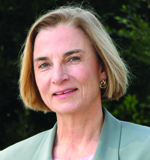November 2013

Patricia W. Finn, MD
This month we celebrate the 30th anniversary of the first successful lung transplant. It was a major accomplishment that remains an important milestone, as it represents the only cure or treatment for many of our patients with devastating diseases. In this month’s Who’s Who, we highlight ATS member Dr. Joel Cooper, who performed the first lung transplant. I urge you to read his inspiring story.
Patients with pulmonary fibrosis, cystic fibrosis, pulmonary hypertension, alpha-1 antitrypsin deficiency and other chronic conditions can live fulfilling lives following lung transplantation. Still, the median survival after lung transplant is the lowest of any solid organ transplant. From identification of biomarkers of rejection to systems biology and characterization of the microbiome in diseased versus healthy lungs, there are members of the ATS hard at work to find a way to increase the survival of patients who could benefit from this life-saving procedure.
Even if we can increase survival, there remains a shortage of organs for both adults and children. In the United States, according to the Organ Procurement and Transplantation Network more than 1,600 patients await lung transplants.
The distribution of organs has been a hot-button topic in recent months–one that touches on questions of health equality. For example, different ethnic groups are disadvantaged in organ transplant, both in the availability of organ matches and rates of survival.
How can we improve the lives of all our own patients–of any type or characteristic–while helping to ensure fairness for everyone? This is a very difficult and complex question that we must ask.
The more general issue of health equality and what ATS can do to promote it was the theme of this year’s ATS Leadership Summit in late September. The summit is an annual gathering of the assembly leaders, committee chairs and members, and ATS Board of Directors. The intention of this meeting is to provide committees a time to meet face to face and to facilitate communication between the committees and assemblies. It is a very exciting weekend, and I love seeing the interactions and learning about what members believe the Society should do to advance the interests of the respiratory community and, ultimately, the health of our patients.
This year, the committees were charged with defining health equality in terms relevant to their committee’s work. Crafting a definition served as a starting point for thinking about how each committee can ingrain health equality into their activities. I was thrilled that many of the committees, even before the summit, were formulating and implementing steps they might take to address questions of health equality that affect the Society and the patients our members serve. For example, the Patient and Family Education Committee is looking at their current educational materials to find ways to make this information accessible and understandable to patients of all backgrounds, and the International Health Committee is consulting with the Education Committee on how to develop a pulmonary training program in Kenya, which has asked the ATS for help in this matter.
Al Thomas, MD, chair of the Health Equality Subcommittee and also the subject of the ATS News October Who’s Who, is collecting strategies from all committees (reminder: the deadline for committees is Jan. 20) and will present these at the February board meeting. If you would like to recommend a health equality strategy and are not a member of an ATS Committee, please feel free to submit your idea directly to me at pwfinn@uic.edu. I look forward to your ideas and learning about the progress committees have made.

